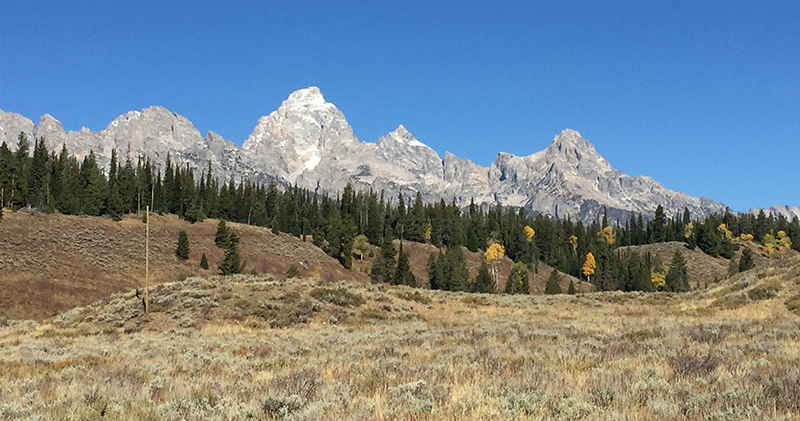The Grand Teton peak is 13,775 feet in height. The Tetons are a part of the Rocky Mountains. Early French voyageurs used the name les trois tetons – the three nipples. It is likely that the Shoshone people once called the whole range Teewinot, meaning “many pinnacles”. The three principal summits of the central masif, is referred to as the Cathedral Group. This jagged series of mountains include 5 peaks over 12,000 feet and 4 over 11,000 feet. It is a striking panorama – one with few rivals. If you have had the good fortune to see Mont Blanc massif, it reaches 15,776 feet between France and Italy. As memorable as those two ranges are, if you have not seen the Denali range in Alaska in person, do it. The mountain begins near sea level and rises out of the plain to 20,310 feet above sea level. Denali, as the native’s called it, has the largest base to peak rise of any mountain situated entirely above sea level. So many things to see, I should have retired earlier.
Last week Karen and I joined friends on a golf/hiking adventure in the Victor, Idaho/Jackson, Wyoming area. We discussed the beauty of fall and the very rugged terrain. Fully expecting to see the abundant wild life that moves to the lower elevations in the fall, we had all of the pertinent viewing gear. Hoping to see a moose in the back country we discussed what we did not want to see up close, a Grizzly. The people we met all reminded us to make lots of noise as we trekked through the lake country around Jenny, String and Leigh lake. You do not want to surprise a bear – especially a Grizzly. The bear is still an endangered species with populations rising from only a few hundred in the mid 1970’s to over 700 now existing in the wild. We joked about meeting the overwhelming animal and our ability to play dead if we were attacked. The old adage that you only have to be faster than everyone else in your hiking party was not a viable response.
The Idaho Statesman this Thursday carried a story about a hunter who was prepared for Grizzly, did everything right and fortunately survived two attacks from the same bear. Make noise as you hike, carry bear spray, if you see a Grizzly make more noise and look as large as you can, don’t run, be especially concerned if there are Cubs with a mother bear. Todd Orr knows the back country and is experienced, even the fool proof bear spray and his training did not keep him from being badly mauled and left as he played dead. When the bear left he ignored his injuries and started a 3 mile hike back to his truck, suddenly he was attacked again and again he relied on his acting skills in the face of what was likely his last moment on earth. It took nearly 8 hours to sew and mend Todd back together from the broken arm and multiple claw and bite wounds. Todd’s story will assure you take your hike in Grizzly country very seriously.
We found three great mountain golf courses, beautiful scenery, good food, but only saw the droppings of the sought after big horn sheep, moose, elk and 10 point buck. We did find some very large Bison on the plain near Jackson, they were grazing with the antelope. The Elk herds arrive soon and if you are planning a trip to Jackson, you will be enjoy the elusive wildlife in the refuge.
When I think I have problems or am having a bad day, I have many reminders of how fortunate I am. Todd said, “Yeah, life sucks in bear country.” The Center for Wildlife Information told National Geographic that bear spray is “the single most important innovation to emerge for both hunters and hikers passing through grizzly country in the last 50 years”. Studies have shown it can stop a bear charging at 35 miles per hour. Believe it – they can run at that speed and weigh over 800 pounds. My final analysis is that being prepared is important, staying calm is critical, and there must be some good luck involved to survive and thrive in an unpredictable world.
Enjoy the week end. M

